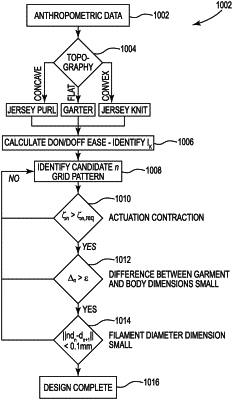| CPC D04B 1/265 (2013.01) [A41D 31/18 (2019.02); A43B 1/04 (2013.01); A43B 23/0265 (2013.01); A61F 13/08 (2013.01); D04B 1/10 (2013.01); D04B 1/18 (2013.01); D04B 1/24 (2013.01); D04B 21/06 (2013.01); D04B 21/207 (2013.01); A41D 2500/10 (2013.01); D10B 2401/046 (2013.01); D10B 2501/04 (2013.01); D10B 2501/043 (2013.01); D10B 2509/028 (2013.01)] | 19 Claims |

|
1. A method for forming a topographically conforming garment, the method comprising:
collecting anthropometric data from a wearer to form a 3D topography, the anthropometric data comprising a series of closed loops arranged around a central axis;
determining the second derivative of the radius of each one of the series of closed loops with respect to angle around the central axis to categorize sections of each of the series of closed loops into convex portions, concave portions, and flat portions;
generating an initial design in which concave portions are knitted with Jersey purl stitch, flat sections are knitted with garter stitch, and convex portions are knitted with Jersey knit stitch, wherein the initial design includes a shape memory material incorporated into each of the sections such that exceeding a transition temperature of the shape memory material causes the Jersey purl stitch to contract and form a concave shape, the garter stitch to contract while remaining flat, and the Jersey knit stitch to contract and form a convex shape;
calculating donning and doffing ease corresponding to the initial design; and
iteratively modifying the design to achieve a desired minimum level of actuation contraction and a maximum size difference between the garment and the anthropometric data while maintaining a desired level of donning and doffing ease.
|